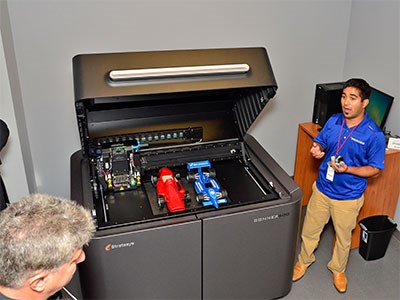Part of living up to the mantra of being responsive to all businesses is keeping up with their constantly changing, dynamic needs.
By entering the ring of cutting edge industry, Canadore and ICAMP have placed themselves on the precipice on one of the core components of modern manufacturing: 3D capabilities and digital prototyping.
While ICAMP boasts an appealing arsenal of tools for manufacturing businesses and innovation leaders, one of the foremost requirements of their clients is the innovative digital design and prototyping pillar.
“One of the fundamental pieces of advanced manufacturing is digital manufacturing,” said Butler-Jones. “It’s based around computer design files that allow you to then make improvements and manufacture more efficiently: that is the fundamental piece to all of this.”
Whether facing a blank slate or confronting a specific problem, ICAMP goes beyond simply creating product designs in 3D.
Instead, it gives development teams a way to analyze a project’s function, explore its ins and outs, all while determining if their end product will succeed or fail before it goes to market.
ICAMP also houses a 12-seat 3D theatre capable of creating 3D prototypes and training simulations, eliminating all speculation with design visualization.
Imagine being able to conceive an idea and test its viability before the commitment to being built, like touring a yet-to-be-built property or undergoing in-depth training in the virtual world, for example.
Now, companies don’t have to imagine; those capabilities and the expertise are, quite literally, at their disposal.
“Without going into the digital world, you’re stuck with manually making adjustments,” Butler-Jones said of traditional methods. “Once we can bring that into a digital file, whether through 3D scanning or reverse engineering, now we can make adjustments inside the computer and see how those are going to react in the real world.”
The incredible accuracy of the digital prototyping has grown to the extent of near-optimal simulations that can help the development team to optimize, validate, and visualize their product before it exists in the real world.
What was once considered the “novelty of tomorrow” is now the top tool of today, and ICAMP has created the opportunities that were not available just a short while ago.
Revolutionary technologies like 3D scanning and printing have captured the imagination of industry at large and, as ICAMP can testify to, businesses of all types from industries in which success is dictated by what you can create, not what you can replicate.
But if you’re like the pool of parties who think 3D technologies and prototyping are interesting, but aren’t quite sure if the capabilities can help them, think again.
ICAMP has been deliberate in simplifying the process for manufacturers to adopt these new platforms, while backing it up with the technical expertise to help those companies deliver without the heavy investment.
From aerospace to mining, ICAMP’s digital prototyping capabilities have already helped industry leaders excel in ways unfathomed just a few short years ago.
Whereas a traditional physical prototyping cycle accounted for a “test and fix” phase, digital prototyping eliminates the unknown by testing thoroughly before a product is developed, reducing the number of physical prototypes, failures and, in turn, significantly reducing cost.
Changes can be made instantly; prototypes reprinted on the same day.
Using their ultimate measurement and inspection tool, the MetraSCAN 3D Optical Scanner, ICAMP can reverse engineer with precision 3D scanning.
Combined with their C-Track 780 dual-laser sensor and the HandyPROBE portable probing system, companies can harness the ability to perform 3D laser scanning with impressive speed and precision.
“The 3D design is that core piece: you need to move the parts that you’re manufacturing into this digital world,” Butler-Jones explained. “If you’re not able to work with the design files and build these things in the computer, all of the other pieces that allow you to increase your productivity and do your product improvements are stuck.”
After being thoroughly scrutinized in the digital realm, those prototypes can then be made tangible. Confronted with a blank slate, these companies are given the ability to make something from nothing, giving birth to an idea others only dream about.
Using the first-ever multi-material 3D printing system, the Objet Connex500 polymer printer, true product realism is realized by bringing the conceptual and visionary to fruition.
Capable of printing more than 100 different materials, ICAMP has found the ideal way to combine their rapid prototyping capabilities to produce parts of all size and function.
But no longer are such technologies an alien, sci-fi sounding fiction that only a privileged few get to use.
Instead, thanks to forward-thinking facilities like ICAMP, these are realms where there is no compromise with second-rate development and no excuse for falling behind.
The only requirement: boundless vision.
And the demand is unarguably there.
For more than a year, the brilliant brains behind ICAMP consulted very closely with industry leaders to find out exactly what advanced pieces of equipment would best serve their needs, but were inaccessible to them privately.
The result is an incredible arsenal of tools that would otherwise be out of reach for small and medium private sector companies.
With ICAMP’s rapid prototyping and vast 3D capabilities, those possibilities are available to those with high expectations and ambitious dreams, giving them a chance to truly maximize what they are capable of.
After all, it’s a matter of when, not if, ICAMP’s digital prototyping procedures become the preferred method for most industries.
“There’s still a lot of companies working manually, outside of the digital world,” said Butler-Jones, “but more and more, the capabilities are getting there that everybody is going to be going digital; they will have to at some point.
“We’ve only just started touching on what’s possible with this kind of manufacturing.”




